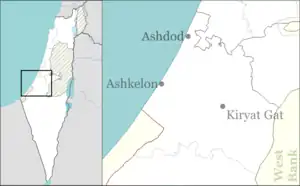Masu'ot Yitzhak
מְשּׂוּאוֹת יִצְחָק مسؤوت اسحاق / مسؤوت يتسحاك | |
|---|---|
| Hebrew transcription(s) | |
| • standard | Mesu'ot Yitzhak |
 | |
 Masu'ot Yitzhak | |
| Coordinates: 31°42′12″N 34°41′22″E / 31.70333°N 34.68944°E | |
| Country | Israel |
| District | Southern |
| Council | Shafir |
| Affiliation | Hapoel HaMizrachi |
| Founded | 1945 (in Gush Etzion) 1949 (current location) |
| Founded by | Central European Jewish immigrants |
| Population (2021) | 685[1] |
| Website | www.massuot.co.il |
Masu'ot Yitzhak (Hebrew: מְשּׂוּאוֹת יִצְחָק, lit. Yitzhak's Beacons) is a moshav shitufi in southern Israel. Located near Ashkelon, it falls under the jurisdiction of Shafir Regional Council. The original kibbutz in Gush Etzion was destroyed and depopulated in the 1948 Arab–Israeli War,[2] and a new settlement was established in 1949 in a different location. In 2021 it had a population of 685.[1]
History
Kibbutz Masu'ot Yitzhak was founded in 1945 in Gush Etzion, midway between Jerusalem and Hebron. The settlers were young pioneers from Hungary, Czechoslovakia, and Germany who arrived before World War II. The kibbutz was named for the chief rabbi of Mandatory Palestine, Yitzhak HaLevi Herzog.[3]
_overlaid_on_the_1943_Survey_of_Palestine_map_of_Beit_Fajjar.jpg.webp) The four kibbutzes of the Gush Etzion at the time of the 1948 war (Kfar Etzion, Ein Zurim, Massuot Yitzhak, Revadim) overlaid on a 1943 Survey of Palestine map
The four kibbutzes of the Gush Etzion at the time of the 1948 war (Kfar Etzion, Ein Zurim, Massuot Yitzhak, Revadim) overlaid on a 1943 Survey of Palestine map Masu’ot Yitzhak founders October 1945
Masu’ot Yitzhak founders October 1945 Musu'ot Yitzhak. 31 October 1945
Musu'ot Yitzhak. 31 October 1945 Masu’ot Yitzhak fencing 1945
Masu’ot Yitzhak fencing 1945 Masu’ot Yitzhak first buildings 1945
Masu’ot Yitzhak first buildings 1945 Masu’ot Yitzhak celebrations 1945
Masu’ot Yitzhak celebrations 1945 Mas'uot Yitzhak, 1947
Mas'uot Yitzhak, 1947
The settlers of Masu'ot Yitzhak rose to the challenge of living in the Judean Mountains, building homes and planting orchards. In 1948, Gush Etzion was captured by the Arab Legion. The residents of Kfar Etzion were massacred, and all other inhabitants of Gush Etzion, including the residents of Masu'ot Yitzhak, were captured and imprisoned in Jordan.[4]
After their return from captivity in 1949, the Masu'ot Yitzhak pioneers established a new moshav of the same name near Shafir, a region inhabited by the Philistines in biblical times. Shafir had served as a base for the southern front of the Israeli army during the 1948 war,[5] and the land on which the new Masu'ot Yitzhak was founded had until shortly beforehand belonged to the depopulated Palestinian village of al-Sawafir al-Gharbiyya.[6]
Tzahali, a military preparatory program for religious girls, is based in Masu'ot Yitzhak.[7]
Economy
The moshav economy is based on agriculture and industry. A reservoir was built 40 years ago to harness the winter flood waters of Nahal Lachish for farming. The water is used to irrigate 125 acres (0.51 km2) of avocado trees.[8]
References
- 1 2 "Regional Statistics". Israel Central Bureau of Statistics. Retrieved 22 February 2023.
- ↑ Eisenberg, Ronald L. (2006). The Streets of Jerusalem: Who, What, Why. Israel: Devora Publishing. p. 249. ISBN 9781932687545.
- ↑ מושב משואות יצחק, שפלה דרומית [Moshav Masuot Yitzhak, Southern Shfela]. Eter HaBayit (in Hebrew). Retrieved April 16, 2019.
- ↑ Eisenberg, Ronald L. (2006). The Streets of Jerusalem: Who, What, Why. Israel: Devora Publishing. p. 249. ISBN 9781932687545.
- ↑ About the community Masu'ot Yitzhak
- ↑ Khalidi, Walid (1992), All That Remains: The Palestinian Villages Occupied and Depopulated by Israel in 1948, Washington D.C.: Institute for Palestine Studies, p. 133, ISBN 0-88728-224-5
- ↑ Shooting Israel: Seeing Jerusalem through the lens of a camera Haaretz
- ↑ Mas'uot Yitzhak reservoir Archived 2010-10-02 at the Wayback Machine Jewish National Fund
Further reading
- Yossi Katz, Between Jerusalem and Hebron: Jewish Settlement in the Pre-State Period
External links
- Village website (in Hebrew)
- Memorial for Masu'ot Yitzhak in Gush Etzion Archived 2007-09-27 at the Wayback Machine Etzion Bloc (in Hebrew)
- Orit Segal (2006): Massu’ot Yizhaq Final Report, Hadashot Arkheologiyot – Excavations and Surveys in Israel, No. 118.